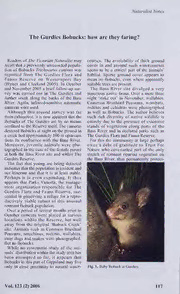
The Gurdies Bobucks: How Are They Faring? PDF
Preview The Gurdies Bobucks: How Are They Faring?
NaturalistNotes The Gurdies Bobucks: how are they faring? Readers ofThe Victorian Naturalist may courses. The availability ofthick ground recall thatapreviously unrecordedpopula- cover in and around such watercourses tion of Bobucks Trichosurus caninus was seems to be a critical part ofthe animals’ reported from The Gurdies Flora and habitat. Sparse ground cover appears to Fauna Reserve on Westernport Bay mean no Bobucks, even where apparently (Hynes and Cleeland 2005). In October suitabletreesarepresent. and November2005 a brieffollow-up sur- The Bass River site divulged a very vey was carried out in The Gurdies and numerous native fauna. Over a mere three further south along the banks ofthe Bass night ‘stake out’ in November, wallabies, River. Again, infrared-sensitive automatic Common Brushtail Possums, wombats, cameraswereused. rodents and echidnas were photographed Although this second survey was far as well as Bobucks. The author believes fromexhaustive, itisnowapparentthatthe such rich diversity of native wildlife is Bobucks ofThe Gurdies are by no means entirely due to the presence ofextensive confinedtothe Reserveitself. Thecameras stands ofvegetation along parts of the detected Bobucks atnighton theground in Bass River and in declared parks such as acreek bedapproximately 100m upstream TheGurdies Flora and Fauna Reserve. from its confluence with the Bass River. For this the community at large perhaps Moreover, juvenile animals were pho- owes a debt of gratitude to Trust For tographed in the care ofthe female parent Nature who covenanted part ofthe only at both the Bass River site and within The stretch ofremnant riparian vegetation on GurdiesReserve. the Bass River, thus permanently protect- The fact that young are being detected indicatesthatthepopulationisresidentand not itinerant and that it is at least stable. Perhaps it is even expanding. It thus appears that Parks Victoria, the manage- ment organisation responsible for The Gurdies Flora and Fauna Reserve, suc- ceeded in preserving a refuge for a repro- ductively viable subset of this unusual remnant Bobuckpopulation. Over a period ofseveral months prior to October cameras were placed at various locations within the Reserve, but well away from the original 'Bobuck Creek’ site. Animals such as Common Brushtail Possums, antechinus, rodents, wallabies, stray dogs and snakes were photographed. Butno Bobucks. While no systematic study ofthe ani- mals’ distribution within thestudyareahas been attempted so far, it appears that Bobucks in thispail ofGippsland may live only in close proximity to natural water- Fig. 1• BabyBobuckatGurdies Vol. 123 (2) 2006 117 BookReviews ing a unique habitat forthese Bobucks and Landcare who likewise proofread and offered othernativecreatures. helpfuladviceinthewritingofthisreport. Additional images of animals so far References recorded in this survey may be viewed at Hynes DandCleeland M (2005) PresenceofBobucks the following website: http;//www.thyla- (Trichosurus caninus) in The Gurdies on coleo.com/news/oct_dec2005/oct_dec2005 Westemport Bay, Victoria. The Victorian Naturalist 122, 141-145. .html Acknowledgements The author wishes to thank Anne and Phil Debbie Hynes Westwood for providing access to the Bass POB285Burwood3125Victoria Riverthat backs their ‘Bassbush’ property, and ThylacoleoImagery,www.thylacoleo.com who provided many suggestions for useful improvementsto the content ofthis article. The author thanks Mike Cleeland of Philip Island Wildlife ofthe Box-Ironbark Country by Chris Tzaros Publisher: CS1ROPublishing, 2005. 256pages,paperbackandCD; colour photographs. ISBN0643069674. RRP$39.95 Local and regional natural history and ofthe remaining Box-ironbarkremnantsare field guides are a useful starting point for tiny, degradedfragments.Take alookat the learning about an area that is new, espe- maps of the 16 Box-ironbark parks and cially when written by someone such as conservationareas inthisbook and you will Chris Tzaros, with a deep knowledge and see that many, although seemingly large, love for the region being described. The arereallyonlysmallerareascobbledtogeth- author writes in the preface to Wildlife of er, many with long, ragged edges. It is theBox-Ironbark Country, T hopethatthis sobering to note that there is only one very book will be used by many people, not small patch ofBox-ironbark remainingthat only workers or students in the field of matchestheofficial criterion ofundisturbed land and wildlife management, community anduncut ‘old-growth’ woodland. extension or regional planning, but also What is left ofthe Box-ironbark forests landholders, naturalists, tourists, and any- and woodlands provides critical habitat for one who may simply wish to learn more a large number of woodland plants and about the wildlife of Victoria’s wonderful animals, now threatened because of box-ironbark country’. I think he has suc- destruction oftheir habitat. Many species, ceeded; there is something in this book for such as the Regent Honeyeater, Swift everyone. This book would be especially Parrot, Squirrel Glider and Brush-tailed useful for newcomers to the Box-ironbark, Phascogale, are dependent on the remnants such as landholders and research students thatremain. who are unfamiliarwiththeregion. The first three chapters provide an excel- Over the past 200 years, Victoria’s Box- lent summary ofthe Box-ironbark region, ironbark forests and woodlands have been its history and its wildlife. The natural dis- so heavily cleared and modified for timber, tribution ofBox-ironbark species, why the mining and farming that now only about region has such a diversity ofspecies and 15% remains, mostly in isolated remnants how they have been affected by the habitat or as corridors along roadsides. Although destruction and modification of the past there are some larger remnants, such as 200 years are covered. A succinct summa- Warby Range State Park (11 084 ha), most ry points out how current land-uses and 118 The Victorian Naturalist
